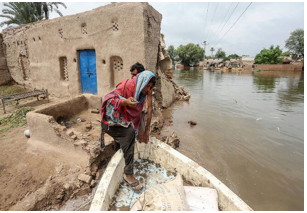INP-WealthPk
Azeem Ahmed Khan
Punjab has borne the brunt of Pakistan’s 2025 floods, accounting for an overwhelming 92 percent of total housing damage and the largest share of overall economic losses among all provinces, according to the Planning Ministry’s Preliminary Assessment Report.
The report shows that Punjab suffered 213,097 out of the 229,763 housing losses recorded nationwide. It further notes that the province also suffered massive agricultural and infrastructure devastation, with submerged croplands, broken bridges, damaged roads, and severe livestock losses threatening livelihoods across rural districts.

The report said that Punjab’s vulnerability stems from its extensive river systems and densely populated floodplains. The 2025 monsoon season brought rainfall up to 50 percent above long-term averages, inundating large areas of central and southern Punjab, including low-lying towns and villages near the Chenab and Sutlej rivers. “Punjab was the epicenter of the humanitarian crisis,” the report observed, adding that nearly four million people were displaced countrywide, with Punjab hosting the largest proportion.
According to the Provincial Disaster Management Authority (PDMA) Punjab, compiled figures show that roads and bridges valued at over Rs137 billion were either destroyed or rendered unusable. The province reported widespread losses of livestock and food crops, including wheat, cotton, and fodder, along with significant damage to small and medium enterprises in flood-hit districts.
Punjab sustained the bulk of the nation’s infrastructure damage, encompassing 2,811 kilometers of roads and a large portion of the 790 bridges affected countrywide. Disrupted connectivity slowed both emergency operations and market access for farmers and traders. The report warned that reconstruction could take up to a decade in the worst-affected areas unless immediate resources were mobilized.
Housing reconstruction alone will require around Rs92 billion, while overall provincial losses are expected to cross Rs400 billion once secondary impacts on employment and rural production are factored in. “These are preliminary figures that will be updated as more data becomes available,” the report clarified, noting that the full extent of damage will only be confirmed after detailed field verification.
Despite the extensive losses, Punjab’s relief and administrative response was swift, supported by the armed forces and federal agencies. Temporary camps were established for displaced families, while emergency food, shelter, and medical supplies were distributed. However, officials acknowledged that long-term rehabilitation—especially housing reconstruction—will require sustained national and international financial backing.
The report emphasized that Punjab’s agricultural and housing sectors must be rebuilt using climate-resilient standards to prevent similar destruction in future disasters. It recommended integrated floodplain zoning, improved drainage systems, and strengthened embankments along major rivers. “Punjab’s experience demonstrates how rapidly changing weather patterns are amplifying disaster intensity,” the document stated, urging policymakers to align provincial development planning with national climate adaptation strategies.
The Ministry of Planning warned that unless structural reforms and resilient infrastructure investments are prioritized, Pakistan’s economic heartland could remain exposed to recurring climate shocks that threaten national food security and GDP growth.
Credit: INP-WealthPk













